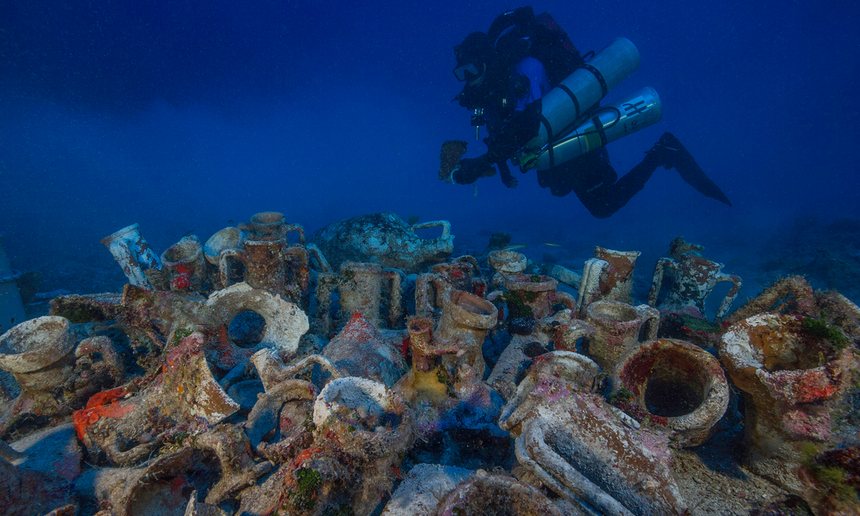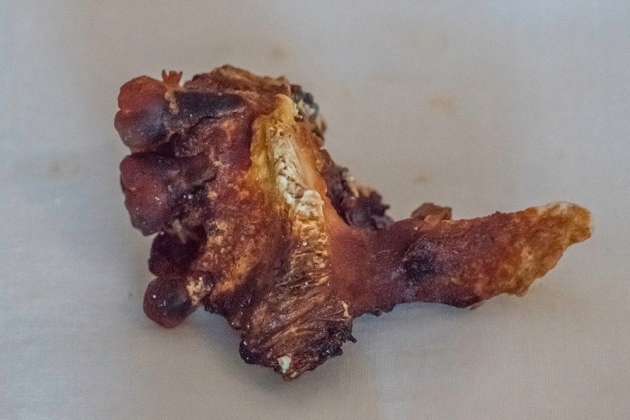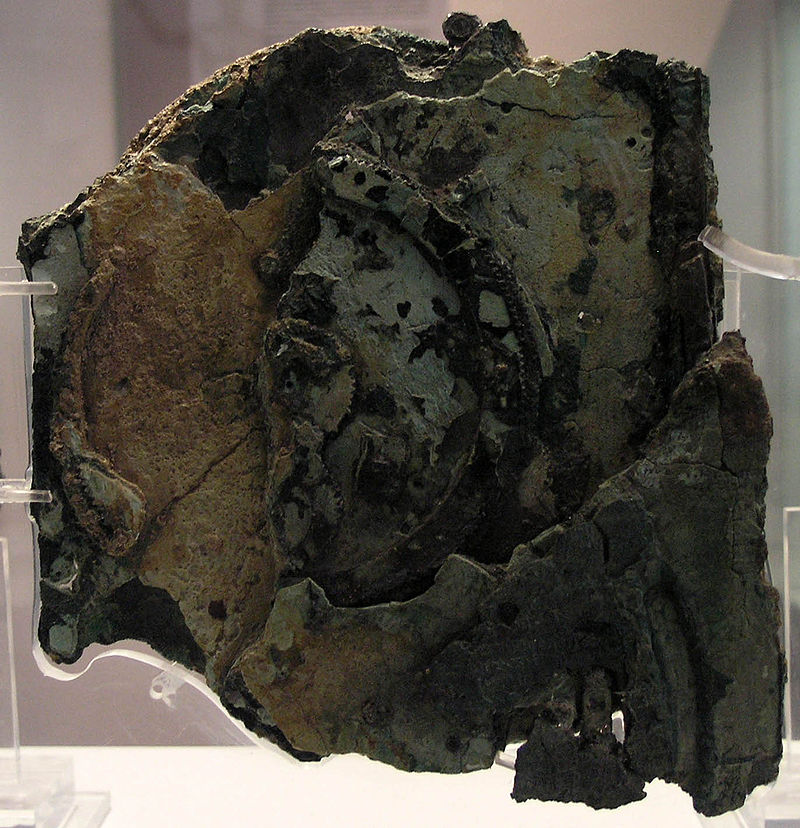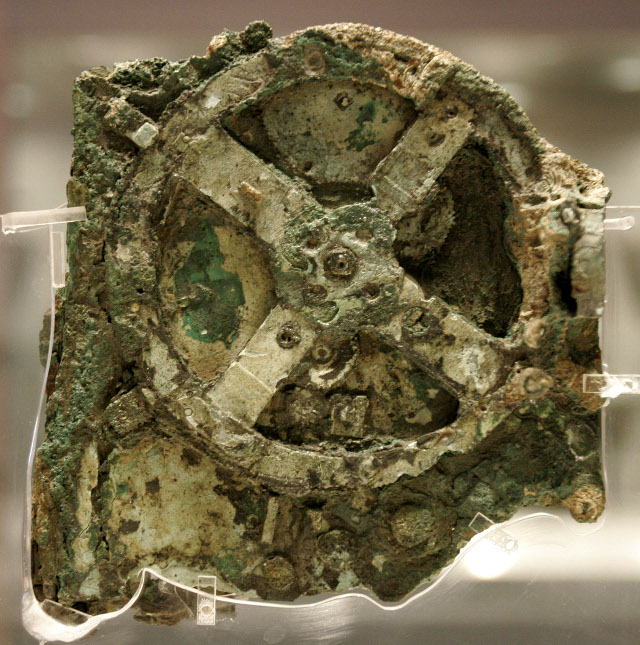A human skeleton was found on the site of the discovery of the Anti-Kite mechanism

At the crash site of the ancient Greek ship, archaeologists discovered a lot of pottery, metal fragments, and, of course, the Antikythera mechanism (source: Brett Seymour / EUA / WHOI / ARGO)
In 1901, from an ancient ship that sank not far from the Greek island of Antikythera (Greek Αντικύθηρα), they raised the remains of an unusual mechanism. It all looked like fragments of corroded bronze, covered with a layer of marine sediments. Initially, these fragments were considered parts of a statue. But archaeologist Valerios Stais, who conducted a survey of fragments in 1902, found out that these are parts of a single mechanism.
This mechanism is called Antikythera at the place of detection. It dates back to about 100 BC, it is not possible to determine its age more accurately. Now, more than a century later, in the place where the ship sank with this device, a human skeleton was found. Archaeologists believe that the ship sank as a result of a collision with rocks. The damage did not allow the 40-meter vessel to keep afloat. A part of the crew drowned with him. The remains of one person found August 31 of this year.
Skeletons in the wrecks of ancient ships are extremely rare, since human bodies are quickly absorbed by marine flora, fauna and microorganisms. But in this case, experts are lucky. The fact is that one of the team members was covered in the crash with fragments of pottery and sand. For this reason, the skeleton has remained virtually untouched. “We are amazed,” said one of the expedition members. “We haven’t done such discoveries yet.”

A piece of jaw removed from underwater near Antikyter Island (source: Brett Seymour, EUA / WHOI / ARGO)
')
If scientists manage to isolate DNA samples from the remains, then it will be possible to perform sequencing, ascertaining where the man came from, who died more than two thousand years ago. This is not the first skeleton, which was found in the place where the ship sank with the Antikythera mechanism. Previous remains were discovered in 1976 by Jacques-Yves Cousteau himself. But fragments of the skeleton raised from the bottom of the sea were conserved with the help of a number of chemicals. Some fragments were not covered with chemicals, but their safety in terms of the possible extraction of genetic material left much to be desired.
The remains found now, according to experts, may well contain preserved DNA samples.
The floor of a man who drowned two thousand years ago is supposedly male. Now scientists are waiting for permission from the Greek authorities to work with the remains. Since they were found on the territory of Greece, they have to ask permission from the authorities of this country. If DNA sequencing can be carried out, it will help to understand some details of the origin of the passenger of the ship (or sailor). Also, scientists will receive a number of important data for historical science.

One of the fragments of the mechanism (source: Wikipedia)
The mechanism itself, as it turned out relatively recently, is an analog computer that was used, possibly, to predict the motion of celestial bodies. In particular, scientists suggest that an ancient computer could show priests where a solar or lunar eclipse could happen. Most recently, it was discovered that, together with the mechanism, its creators sent instructions for use. The size of the mechanism was supposedly 33 × 18 × 10 cm.
The Antikythera Mechanism Research Project (AMRP) has been working on the study of the Antikythera Mechanism for many years. Specialists have at their disposal all the latest achievements of science and technology. To read the instructions and study the mechanism used tomography, computer simulation, fluoroscopy and much more.
It was possible to read the instructions only now. According to the “handwriting”, it was possible to determine that two people inscribed inscriptions. They worked, most likely, in one workshop. Moreover, you can even determine the approximate location of the ancient workshop. This is most likely the island of Rhodes. The fact is that the mechanism was set up to work with astronomical events at 35 degrees north latitude.
The instruction was engraved with 1.2 mm symbols on a bronze surface. Scientists were able to identify 3400 characters (about 500 words). Most likely, there were several times more words - about 2000-2500.

Photo: The Associated Press
Maybe with the help of the apparatus the Greeks tried to predict the future. And not only his people, but the entire civilization known to the Greeks at that time. In the instruction, discovered by scientists, the observer is told about what he can see during the operation of the mechanism. The phenomena themselves are not explained in any way - most likely, this should have been understood by the person who carried the analog computer.
Presumably, ancient Greek scientists such as Hipparch (190-120 BC) and Gemin (I century BC) are related to the creation of the device. They worked precisely on the island of Rhodes. Scientists do not know about other famous astronomers of that time who lived and worked near Rhodes or on the island itself. So it is likely that the creators of the device are exactly the two ancient astronomers, as mentioned above.

Photo: Petros Giannakouris / Associated Press
The remains of a man at the site of the sunken ship of the Greeks found as a result of the planned excavations. It may well be that scientists will soon be able to find something else that will shed additional light on the origin of the Antikythera mechanism.
Source: https://habr.com/ru/post/372689/
All Articles